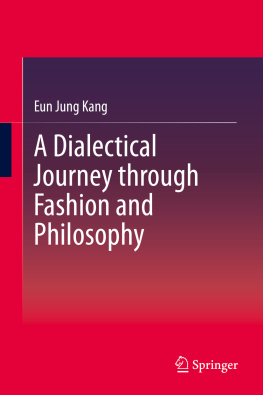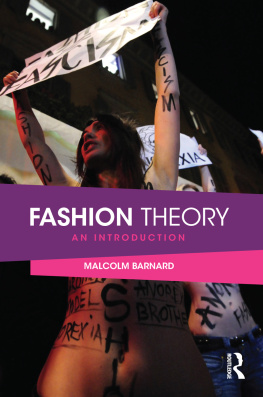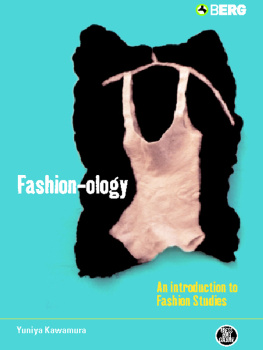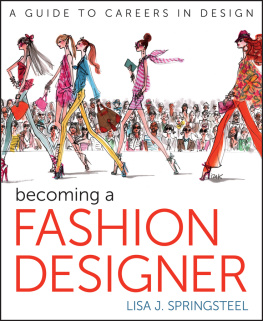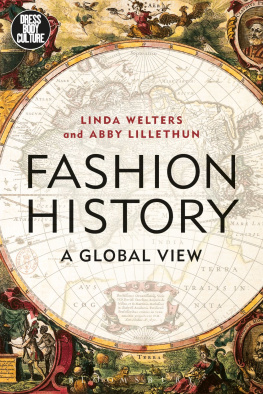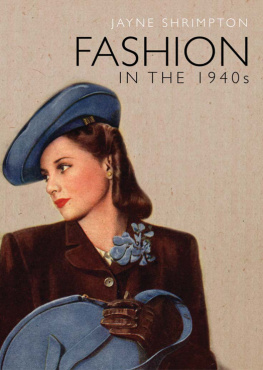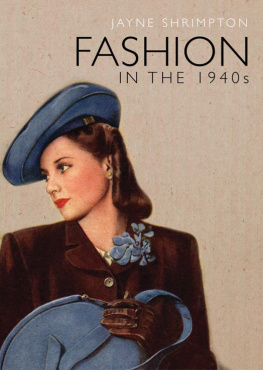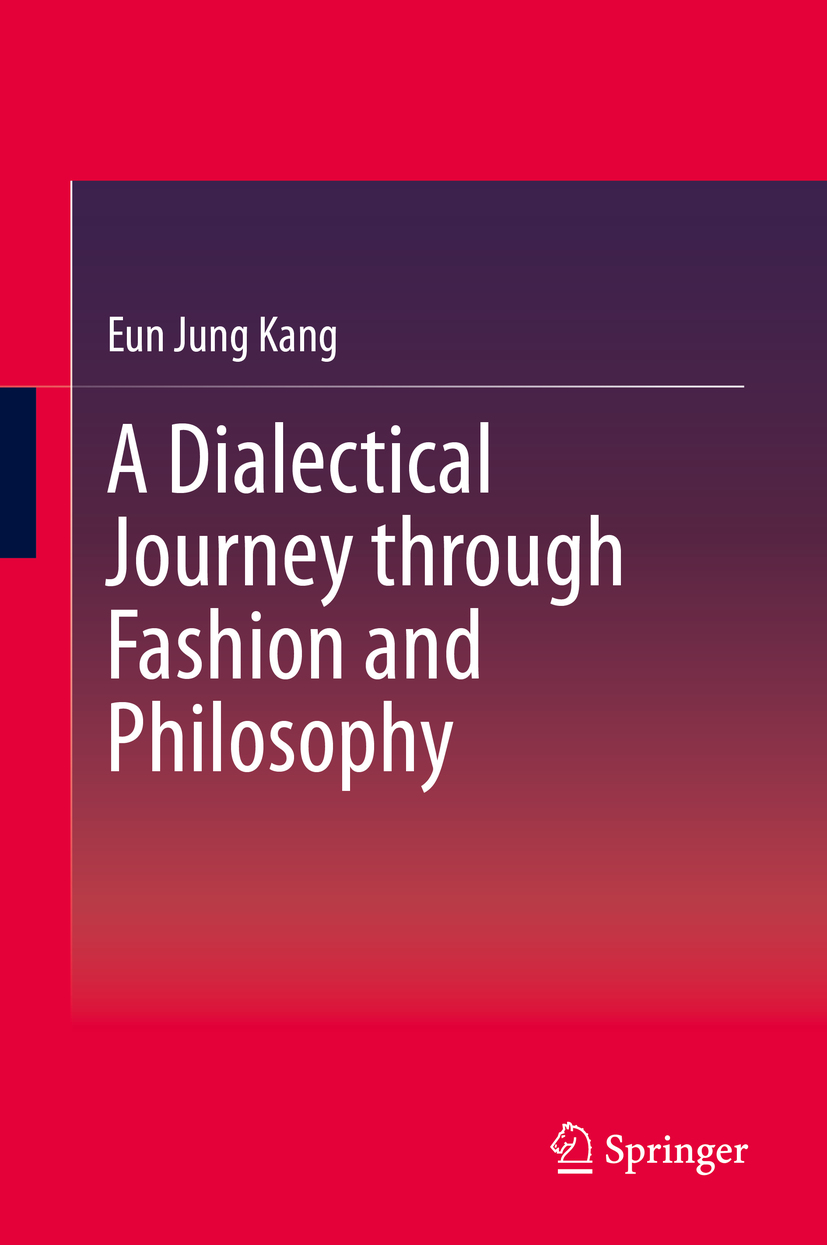Eun Jung Kang
A Dialectical Journey through Fashion and Philosophy
Eun Jung Kang
Department of Fashion Design, Sungkyunkwan University, Seoul, Korea (Republic of)
ISBN 978-981-15-0813-4 e-ISBN 978-981-15-0814-1
https://doi.org/10.1007/978-981-15-0814-1
Springer Nature Singapore Pte Ltd. 2019
This work is subject to copyright. All rights are reserved by the Publisher, whether the whole or part of the material is concerned, specifically the rights of translation, reprinting, reuse of illustrations, recitation, broadcasting, reproduction on microfilms or in any other physical way, and transmission or information storage and retrieval, electronic adaptation, computer software, or by similar or dissimilar methodology now known or hereafter developed.
The use of general descriptive names, registered names, trademarks, service marks, etc. in this publication does not imply, even in the absence of a specific statement, that such names are exempt from the relevant protective laws and regulations and therefore free for general use.
The publisher, the authors, and the editors are safe to assume that the advice and information in this book are believed to be true and accurate at the date of publication. Neither the publisher nor the authors or the editors give a warranty, expressed or implied, with respect to the material contained herein or for any errors or omissions that may have been made. The publisher remains neutral with regard to jurisdictional claims in published maps and institutional affiliations.
This Springer imprint is published by the registered company Springer Nature Singapore Pte Ltd.
The registered company address is: 152 Beach Road, #21-01/04 Gateway East, Singapore 189721, Singapore
Preface
Topics related to fashion have long been considered part of a somatic-sartorial domain whose main concerns are confined primarily to the body and bodily matters. Much literature on the politics behind appearance and bodily issues that are tied to fashion attests to this connection. Given this strong tendency, overcoming the inclination in academic circles not to accept fashion as a subject matter of philosophical discussion would seem to be a formidable task. Nonetheless, fashion is profoundly intertwined with distinctively modern issues that belong to the realm of the mind as well as to that of the body. Probably no other modern concepts or phenomena are comparable to fashion in terms of the manifestation of the proximity between philosophy and the mode of life in modern times. A proper philosophical probe into fashion should reveal that philosophy is interlaced with issues related not only to the mind but also to the body, and fashion hypostasizes the relation between individual and collective that has its origin in the subject-object dichotomy , which is one of the central themes of modern philosophy. Coming to grips with fashion helps us take in some of the most enigmatic philosophical questions, for example, how noumenon and thing-in-itself are different; how synthetic a priori cognition is possible in our mundane life; how one is unceasingly searching for oneself in [Kantian] time; how freedom and unfreedom have reciprocal relations with each other; and how [Hegelian] objectification is different from [Marxist] alienation . It is not a coincidence that fashion, one of the most mundane objects/concepts in everyday life, can be examined with philosophical underpinnings of such thinkers as Immanuel Kant, G. W. F. Hegel, Georg Simmel , Theodor W. Adorno, and Walter Benjamin, for it is one cardinal momentum of modernity as a source of newness as well as a medium of the pursuit of newness while, dialectically speaking, an outcome of modernity. Fashion does not pertain to all philosophical topics related to the new, because it is specific to the time called modernity. As such, philosophical investigations into fashion that involve such modern concepts as change, newness, and individual freedom in relation to collective freedom can disclose the ontological affinity between fashion and modernity .
This book is neither a coherent philosophy of fashion armed with a grand sweep of ideas in respect of fashion nor a prime example of a philosophical approach to fashion studies in one direction only, as its main focus is on the process of elucidating philosophy as well as philosophizing fashion, which, however, are not disparate endeavors in this interdisciplinary undertaking. The aim of this project is to provide one way to analyze fashion through philosophical discourse while at the same time suggesting one way to do philosophization by applying systematic philosophical analysis back to the objective world. Clarifying fashion through philosophical discussion makes philosophy easier to comprehend; explicating philosophy through fashion brings fashion into the light as a distinctively modern phenomenon that is critical for grasping the trajectory of modernity. By investigating the essence of fashion through philosophical scrutiny, the nexus between fashion and modernity becomes easier to identify, and fashion can gain recognition as an area of critical inquiry. The philosophization of fashion carried out in this book has several significances: (1) it gives us a clearer understanding of fashions close connection to the development of modernity; (2) it opens doors for redeeming fashion from the objective, bodily world and positioning it as an indispensable part of the humanities; and (3) it is a direct application of philosophical discourse and concepts to fashion, demonstrating how metaphysics is of practical use in understanding the human mind and how it is embedded in empirical reality. Hence, the questions raised and postulates proposed in this book while in search of the attributes of fashion should assist philosophers in resolving philosophical quandaries; in turn, my philosophical methodology and inquiries should help fashion scholars comprehend the essential qualities of fashion as a concept and as a phenomenon that are intertwined with the development of modernity .
Eun Jung Kang
Seoul, Republic of Korea
Acknowledgments
This monograph is a revised and expanded version of my dissertation, Fashion: The Sine Qua Non of Modernity, at Cornell University in August of 2012. I am indebted to Susan Buck-Morss, who served as a member of my dissertation committee, for her support, without which I would not have been able to graduate with a Ph.D. degree at Cornell. Cornell University supported me during the years of research and writing, which helped to shape mere ideas into a dissertation. The Department of Fiber Science and Apparel Design at Cornell University funded my doctoral program with a generous fellowship and grants. I would like to thank Alexandra Campbell and Ameena Jaafar at Springer Nature for their tireless efforts to bring this project to life. I would also like to thank Richard Harris, Gary Rector, Neil Armstrong, and Laura Glenn for all their help. In addition, I would like to extend my appreciation to the reviewers for their comments.
Introduction
My fascination with philosophy began when I found out that philosophy is the best tool to make a logical analysis about the underlying structure of fashion, especially in the manner that is in consonance with what is generally viewed as analytic philosophy today. However, I soon realized that the exploration of fashion by drawing on philosophy requires answering a range of questions that is more in line with continental philosophy as well. My very first quandary about fashion as part of this philosophical undertaking was a methodological question as to how to dissect fashion into a concept and a phenomenon, as the essence of fashion is something that is communicated in our mind, while fashion is also something tangible or concrete, something that exists as an object or a phenomenon. I searched for a scientific method by means of which to separate these two disparate predicates of fashion theoretically. Indeed, this was the very starting point of this book. The rest of this book is shaped while answering a series of ensuing questions after my initial search for a methodological instrument. It is Immanuel Kants schematism that not only availed me in moving on with a theoretical framework to divorce the conceptual and the phenomenal of fashion but also supplied an impetus for me to carry out further philosophical investigations into fashion; Kants notion of a priori sensible intuitions of time and space aided me in breaking down the mechanism of the concept of newness , which is indispensable to the construction of fashion as a concept and a phenomenon. Nonetheless, with Kants metaphysics , in which figurative and intellectual transcendental syntheses are intertwined with different aspects of the Kantian dualism between understanding and sensibility , and between categories and intuitions, I was not able to construe the workings of universal consciousness , which is evident in fashion phenomena. Due to the peculiar nature of fashion, which entails the relay between such polar opposites as subject and object, individual and collective, union and separation, and particular and universal, fashion cannot be bound in connection only with the mental activities that are confined to the thinking/perceiving subject. In Kants transcendental idealism , objects in time and space exist merely through self-consciousness , and even the empirical self remains as object, while the transcendental subject is the principle of the unity of apperception of the manifold. The transcendental subject is the combining act of judgment of knowledge or consciousness of the subject, not the subject itself, illustrating the Kantian chasm between

